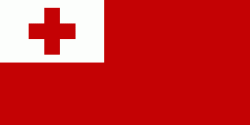Fuaʻamotu International Airport (Fuaʻamotu International Airport)
Fuaamotu International Airport is an international airport in Tonga. It is on the south side of the main island, Tongatapu, 20 km from the capital of Tonga, Nukualofa. Although named after the nearby village of Fuaʻamotu, which is on Tungī's (the king's) estate, in reality the airfield is located on the Tui Pelehake's estate, closer to the village of Pelehake (which did not yet exist as a village during the early aviation days).
The air field was constructed by Seabees of the 1st Construction Battalion with assistance and labor of the U. S. Army 147th Infantry Regiment. It was intended as a World War II heavy bomber field, and had three coral-surfaced runways. In the late 1970s, it was expanded to permit jet aircraft to use the runways. Fuaamotu is now suitable for up to Boeing 767 size aircraft, but remains closed to larger jets (e.g. Boeing 747s).
Fuaamotu International Airport is equipped with VOR/DME (114.5) and NDB (245) navigational facilities. No ILS is available. Lighting is provided for the runway, apron, and taxiway. International airlines with regular services to Fuaamotu include Air New Zealand and Fiji Airways. Fiji Airways flies Boeing 737-800 aircraft from Nadi and ATR 42-500 aircraft from Suva (operated by Fiji Link). Air New Zealand flies Airbus A320 and Boeing 787 aircraft from Auckland. In March 2016, Air New Zealand announced plans to serve Fuaamotu with a one-off Boeing 787-9s for the Auckland–Tonga route due to demand on June 15, 2016. Virgin Australia flew a Boeing 737-800 from Sydney and Auckland until services were withdrawn in 2020. Under Tongan law, Fuaamotu International Airport is closed on Sundays — only to be opened in distress, after the minister's approval.
Fuaamotu is a total controlled aerodrome and all traffic are guided by air traffic control. The tower is contactable on 118.5, and Ground on 121.9. Outside of the hours of service at Fuaamotu a limited FIS is available by Auckland Oceanic.
Runway 11/29: (Elev 91 ft/28m) PCN 45 FBXT (Flexible pavement, medium subgrade strength, medium tyre pressure (1500 kPa), technical evaluation completed). Runway End Identifier Lights are installed at each end of the runway, as are T-VASI glidescope indicators. Low Intensity Runway Lighting is provided, and a simple Low Intensity Lighting Approach Lighting System is installed on Runway 11.
The air field was constructed by Seabees of the 1st Construction Battalion with assistance and labor of the U. S. Army 147th Infantry Regiment. It was intended as a World War II heavy bomber field, and had three coral-surfaced runways. In the late 1970s, it was expanded to permit jet aircraft to use the runways. Fuaamotu is now suitable for up to Boeing 767 size aircraft, but remains closed to larger jets (e.g. Boeing 747s).
Fuaamotu International Airport is equipped with VOR/DME (114.5) and NDB (245) navigational facilities. No ILS is available. Lighting is provided for the runway, apron, and taxiway. International airlines with regular services to Fuaamotu include Air New Zealand and Fiji Airways. Fiji Airways flies Boeing 737-800 aircraft from Nadi and ATR 42-500 aircraft from Suva (operated by Fiji Link). Air New Zealand flies Airbus A320 and Boeing 787 aircraft from Auckland. In March 2016, Air New Zealand announced plans to serve Fuaamotu with a one-off Boeing 787-9s for the Auckland–Tonga route due to demand on June 15, 2016. Virgin Australia flew a Boeing 737-800 from Sydney and Auckland until services were withdrawn in 2020. Under Tongan law, Fuaamotu International Airport is closed on Sundays — only to be opened in distress, after the minister's approval.
Fuaamotu is a total controlled aerodrome and all traffic are guided by air traffic control. The tower is contactable on 118.5, and Ground on 121.9. Outside of the hours of service at Fuaamotu a limited FIS is available by Auckland Oceanic.
Runway 11/29: (Elev 91 ft/28m) PCN 45 FBXT (Flexible pavement, medium subgrade strength, medium tyre pressure (1500 kPa), technical evaluation completed). Runway End Identifier Lights are installed at each end of the runway, as are T-VASI glidescope indicators. Low Intensity Runway Lighting is provided, and a simple Low Intensity Lighting Approach Lighting System is installed on Runway 11.
| IATA Code | TBU | ICAO Code | NFTF | FAA Code | |
|---|---|---|---|---|---|
| Telephone | Fax | ||||
| Home page |
Map - Fuaʻamotu International Airport (Fuaʻamotu International Airport)
Map
Country - Tonga
 |
 |
| Flag of Tonga | |
First inhabited roughly 2,500 years ago by the Lapita civilization, Tonga's Polynesian settlers gradually evolved a distinct and strong ethnic identity, language, and culture as the Tongan people. They were quick to establish a powerful footing across the South Pacific, and this period of Tongan expansionism and colonization is known as the Tuʻi Tonga Empire. From the rule of the first Tongan king, ʻAhoʻeitu, Tonga grew into a regional power. It was a thalassocracy that conquered and controlled unprecedented swathes of the Pacific, from parts of the Solomon Islands and the whole of New Caledonia and Fiji in the west to Samoa and Niue and even as far as parts of modern-day French Polynesia in the east. Tuʻi Tonga became renowned for its economic, ethnic, and cultural influence over the Pacific, which remained strong even after the Samoan revolution of the 13th century and Europeans' discovery of the islands in 1616.
Currency / Language
| ISO | Currency | Symbol | Significant figures |
|---|---|---|---|
| TOP | Tongan paʻanga | T$ | 2 |
| ISO | Language |
|---|---|
| EN | English language |
| TO | Tongan language |















